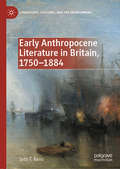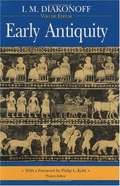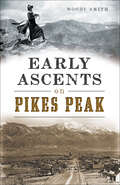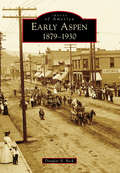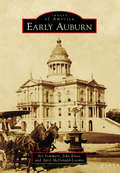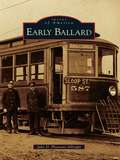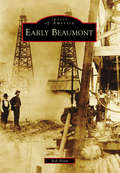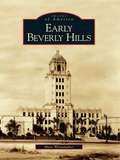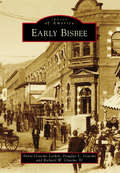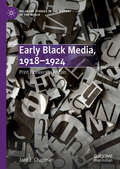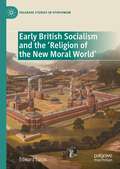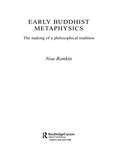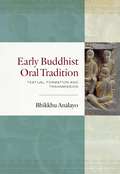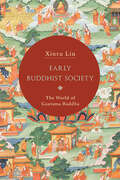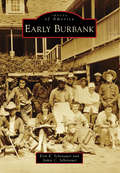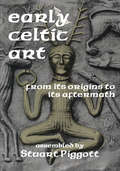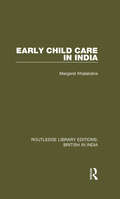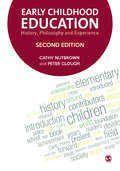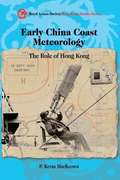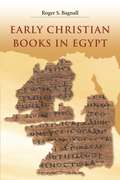- Table View
- List View
Early Anthropocene Literature in Britain, 1750–1884 (Literatures, Cultures, and the Environment)
by Seth T. RenoThis book questions when exactly the Anthropocene began, uncovering an “early Anthropocene” in the literature, art, and science of eighteenth- and nineteenth-century Britain. In chapters organized around the classical elements of Earth, Fire, Water, and Air, Seth Reno shows how literary writers of the Industrial Era borrowed from scientists to capture the changes they witnessed to weather, climate, and other systems. Poets linked the hellish flames of industrial furnaces to the magnificent, geophysical force of volcanic explosions. Novelists and painters depicted cloud formations and polluted urban atmospheres as part of the emerging discipline of climate science. In so doing, the subjects of Reno’s study—some famous, some more obscure—gave form to a growing sense of humans as geophysical agents, capable of reshaping Earth itself. Situated at the interaction of literary studies, environmental studies, and science studies, Early Anthropocene Literature in Britain tells the story of how writers heralded, and wrestled with, Britain’s role in sparking the now-familiar “epoch of humans.”
Early Antiquity
by I. M. DiakonoffThe internationally renowned Assyriologist and linguist I. M. Diakonoff has gathered the work of Soviet historians inthis survey of the earliest history of the ancient Near East, Central Asia, India, and China. Diakonoff and hiscolleagues, nearly all working within the general Marxisthistoriographic tradition, offer a comprehensive, accessiblesynthesis of historical knowledge from the beginnings ofagriculture through the advent of the Iron Age and the Greekcolonization in the Mediterranean and the Black Sea areas. Besides discussing features of Soviet historicalscholarship of the ancient world, the essays treat thehistory of early Mesopotamia and the course of PharaonicEgyptian civilization and developments in ancient India andChina from the Bronze Age into the first millennium B. C. Additional chapters are concerned with the early history ofSyria, Phoenicia, and Palestine, the Hittite civilization, the Creto-Mycenaean world, Homeric Greece, and the Phoenicianand Greek colonization. This volume offers a unified perspective on earlyantiquity, focusing on the economic and social relations ofproduction. Of immense value to specialists, the book willalso appeal to general readers. I. M. Diakonoff is a senior research scholar of ancienthistory at the Institute of Oriental Studies, LeningradAcademy of Sciences. Philip L. Kohl is professor ofanthropology at Wellesley College.
Early Ascents on Pikes Peak (American Chronicles Ser.)
by Woody SmithAn intriguing, firsthand look at what it was like to ascend the storied Colorado mountain and experience its allure in the early days of the Old West. Magnificent Pikes Peak rises dramatically from the Colorado prairie to a height of 14,114 feet above sea level. Visible for one hundred miles around, the granite giant&’s magnetic appeal compelled rugged mountaineers more than a century ago to risk loose saddles, electrical storms and even murder on treacherous expeditions to the summit. First known as Long Mountain by the Indigenous peoples who sojourned at its hot springs, Pikes Peak was a full-fledged tourist destination by the 1870s. Eager men and women ventured up and down by foot, horse, burro, stagecoach, rail and bicycle. Colorado Mountain Club historian Woody Smith captures the news of the era to recount the thrill of pioneer days on America&’s most famous mountain.
Early Aspen: 1879-1930
by Douglas N. BeckUntil 1879, the Roaring Fork Valley was home to a band of Colorado Ute Indians. All of that changed in the summer and fall of that year, when two prospecting teams came to the valley to stake their claims, some of which went on to produce millions of dollars of silver. Within five years, Aspen was home to over 20,000 individuals including miners, lawyers, families, businessmen, and even prostitutes. Aspen's fortune was tied to silver. More importantly, its fate was ultimately tied to the Sherman Silver Purchase Act of 1890, which required the US government to buy 4.5 million ounces of silver per month. From 1890 to 1893, the Sherman Act kept Aspen alive and growing. With the repeal of the act, Aspen began a slow, painful decline. This book covers the years of Aspen's discovery, through the years of decline, and into what is known as the "Quiet Years."
Early Auburn
by John Knox Art Sommers April Mcdonald-LoomisLocated at the junction of gold-rich ravines, Auburn was the site of the first gold discovery in Placer County. Though the superficial gold was quickly panned out, by 1850, the town had become an important trading center. Auburn became a center for goods, services, entertainment, and a place for miners to "winter-over." More importantly, it became a transportation hub. As the county seat, Auburn's hotels, saloons, and merchants experienced a steady stream of customers as county residents came to town to deal with legal matters. Though plagued by numerous destructive fires, the citizens of Auburn rebuilt, and the town continued to thrive. This book will introduce the reader to some of the individuals who were instrumental in shaping Auburn as it grew into the town it is today.
Early Ballard
by Julie D. Pheasant-AlbrightThe first land claim in what would become the city of Ballard was made in 1852, but it wasn't until a ship captain named William Rankin Ballard lost a bet with a business partner and found himself the owner of 160 acres of seemingly worthless land that the city prospered and became the "Shingle Capital of the World." Incorporated in 1890, Ballard grew quickly, thanks to shingle and lumber mills and the Scandinavian fishing fleet. When a horse was supposedly found in the city water supply in 1906, reluctant Ballardites voted to be annexed to the city of Seattle, and the flag flew at half-staff at Ballard City Hall. Home to the Nordic Heritage Museum, Chittenden Locks, and the fishing fleet, this bustling city-within-a-city still retains its unique Scandinavian flavor to this day.
Early Beaumont
by Rob BlainBeaumont was born when the thickly wooded banks of the Neches River were settled in the 1820s. Businessmen and adventurers stayed in the area once they saw the advantages of the river and the region's abundance of timber and other agricultural resources. By 1880, Beaumont was a lumber, ranching, farming, and shipping center. The railroad spurred population growth from 2,500 to 5,000, then Providence intervened: the Lucas Gusher at Spindletop blew in on January 10, 1901, and suddenly more oil than had ever been seen ushered in a new world. The Rockefeller Standard Oil monopoly may have ended in the courts, but Spindletop's oil dwarfed the known world supply, creating companies like Humble Oil (now ExxonMobil), Gulf, and Texaco. Beaumont continued to grow, and with a second boom in 1925, flowing oil brought more people and the building of a gracious city.
Early Beverly Hills
by Marc WanamakerWay before Rodeo Drive and the "pink palace" of the Beverly Hills Hotel were built, way before the namesake hillbillies, its zip code, and Eddie Murphy's detective techniques reaffirmed its place in popular culture, and way before its 1,001 mansions, Beverly Hills was comprised of wild canyons and ranchlands. Burton Green, one of the three original land developers of the Rancho Rodeo de las Aguas, named this place of severe terrain after Beverly Farms, Massachusetts, a 19th-century spa. Since its establishment in 1907, Beverly Hills, California, has been a crossroads for the great movers and shakers of the entertainment industry as well as the tycoons, world leaders, and flotsam and jetsam magnetized by the limelight. The vintage photographs in this provocative volume illustrate Beverly Hills's early transition from cow pastures to Hollywood's extremely illustrious bedroom community.
Early Bisbee
by Annie Graeme Larkin Douglas L. Graeme Richard W. Graeme IVBefore Bisbee became a bustling mining camp, it was a haven to Native Americans for centuries. However, their presence brought the intrusion of army scouts and prospectors into the Mule Mountains. The coincidental discovery of vast mineral wealth at the future site of Bisbee permanently affixed the fate of the land forever. Rising from the remote desert was a dynamic mining city, a city that grew into one of the most influential communities in the West. Bisbee was unique in the Old West because of the mixed moral values. High society and the decadent underworld lived in a delicate balance, but a vibrant multicultural community was forged from these social fires.
Early Black Media, 1918–1924: Print Pioneers in Britain (Palgrave Studies in the History of the Media)
by Jane L. ChapmanThis book represents the first systematic attempt to analyse media and public communications published in Britain by people of African and Afro-Caribbean origin during the aftermaths of war, presenting an in-depth study of print publications for the period 1919-1924. This was a period of post-conflict readjustment that experienced a transnational surge in special interest newspapers and periodicals, including visual discourse. This study provides evidence that the aftermath of war needs to be given more attention as a distinctly defined period of post-conflict adjustment in which individual voices should be highlighted. As such it forms part of a continuing imperative to re-discover and recuperate black history, adding to the body of research on the aftermaths of The First World War, black studies, and the origins of diaspora.Jane L. Chapman analyses how the newspapers of black communities act as a record of conflict memory, and specifically how physical and political oppression was understood by members of the African Caribbean community. Pioneering black activist journalism demonstrates opinions on either empowerment or disempowerment, visibility, self-esteem, and economic struggles for survival.
Early Blues: The First Stars of Blues Guitar
by Jas ObrechtWinner of the 2016 Living Blues Award for Blues Book of the Year Since the early 1900s, blues and the guitar have traveled side by side. This book tells the story of their pairing from the first reported sightings of blues musicians, to the rise of nationally known stars, to the onset of the Great Depression, when blues recording virtually came to a halt.Like the best music documentaries, Early Blues: The First Stars of Blues Guitar interweaves musical history, quotes from celebrated musicians (B.B. King, John Lee Hooker, Ry Cooder, and Johnny Winter, to name a few), and a spellbinding array of life stories to illustrate the early days of blues guitar in rich and resounding detail. In these chapters, you&’ll meet Sylvester Weaver, who recorded the world&’s first guitar solos, and Paramount Records artists Papa Charlie Jackson, Blind Lemon Jefferson, and Blind Blake, the &“King of Ragtime Blues Guitar.&” Blind Willie McTell, the Southeast&’s superlative twelve-string guitar player, and Blind Willie Johnson, street-corner evangelist of sublime gospel blues, also get their due, as do Lonnie Johnson, the era&’s most influential blues guitarist; Mississippi John Hurt, with his gentle, guileless voice and syncopated fingerpicking style; and slide guitarist Tampa Red, &“the Guitar Wizard.&”Drawing on a deep archive of documents, photographs, record company ads, complete discographies, and up-to-date findings of leading researchers, this is the most comprehensive and complete account ever written of the early stars of blues guitar—an essential chapter in the history of American music.
Early Brazil
by Clive Willis"Early Brazil presents a collection of original sources, many published for the first time in English and some never before published in any language, that illustrates the process of conquest, colonization, and settlement in Brazil. The volume emphasizes the actions and interactions of the indigenous peoples, Portuguese, and Africans in the formation of the first extensive plantation colony based on slavery in the Americas, and it also includes documents that reveal the political, social, religious, and economic life of the colony. Original documents on early Brazilian history are difficult to find in English, and this collection will serve the interests of undergraduate students, as well as graduate students, who seek to make comparisons or to understand the history of Portuguese expansion"--
Early British Socialism and the ‘Religion of the New Moral World’ (Palgrave Studies in Utopianism)
by Edward LucasThis book challenges existing accounts of the role of religion in early-nineteenth-century British socialism. Against scholarly interpretations which have identified Owenite socialists as anti-religious or as imitating Christianity, this book argues that Owenites offer a re-conception of the nature of ‘religion’ as advanced through knowledge of the natural and social world, as a prospective source of solidarity which could serve as the unifying bond for communities, and as constituted by ethical conduct. It shows how this re-conception was formed through a sincere and considered reflection upon the problem of religious truth and was shaped by the particular religious context of early-nineteenth-century Britain. It then demonstrates the importance of this reimagination of religion to their understanding of socialism. Their religious interests were not an eccentric adornment to their socialism, an outdated residue yet to be shed and encumbering the development of a mature socialism, or merely instrumental to their temporal goals. Instead, Owenite ambitions of religious reform were grounded in the philosophical preoccupations which animated their socialism.
Early Buddhist Artisans and Their Architectural Vocabulary
by S SettarThe early Buddhist architectural vocabulary, being the first of its kind, maintained its monopoly for about half a millennium, beginning from the third century BCE. To begin with, it was oral, not written. The Jain, Hindu, and other Indian sectarian builders later developed their vocabulary on this foundation, though not identically. This book attempts to understand this vocabulary and the artisans who first made use of it. Print edition not for sale in South Asia (India, Sri Lanka, Nepal, Bangladesh, Pakistan and Bhutan)
Early Buddhist Metaphysics: The Making of a Philosophical Tradition
by Noa RonkinEarly Buddhist Metaphysics provides a philosophical account of the major doctrinal shift in the history of early Theravada tradition in India: the transition from the earliest stratum of Buddhist thought to the systematic and allegedly scholastic philosophy of the Pali Abhidhamma movement. Entwining comparative philosophy and Buddhology, the author probes the Abhidhamma's metaphysical transition in terms of the Aristotelian tradition and vis-à-vis modern philosophy, exploits Western philosophical literature from Plato to contemporary texts in the fields of philosophy of mind and cultural criticism.
Early Buddhist Oral Tradition: Textual Formation and Transmission
by Venerable Analayo BhikkhuA fascinating investigation into the formation and transmission of the early Buddhist oral tradition.For hundreds of years after his death, the Buddha&’s teachings were transmitted orally, from person to person. In this volume, acclaimed scholar-monk Bhikkhu Analayo examines the impact of such oral transmission on early Buddhist texts, be these monastic rules, verses, or prose portions of the early discourses. He scrutinizes various oral aspects of these texts, surveying evidence for memory errors, the impact of attempts at systematization, and instances of additions and innovations. Finally, he explores the implications of the nature of these texts as the final product of centuries of oral transmission and evaluates the type of conclusions that can—and cannot—be drawn based on them.
Early Buddhist Society: The World of Gautama Buddha
by Xinru LiuA richly scholarly yet accessible and imaginative account of society in the time of the Buddha.What might daily life have been like in India in the time of the Buddha? Who were some of the rulers, monks, philosophers, devotees, and doctors with whom the Buddha would have interacted and had discussions? What was involved in spreading the message of Buddhism and setting up the Buddhist sangha (order)? What were the schisms and factions, and what was the nature of opposition to Buddhism from Brahmin hegemony?A great deal is known about Buddhist tenets and doctrine, but very little exists on the lived context of the Buddha himself. Early Buddhist texts in Pali reveal a society in ways that other texts relating to Buddhism, as well as the Brahmanical literature, do not. Xinru Liu reads this literature, along with the earliest Buddhist artworks on stupas, to argue that the historical Buddha does not really exist in the imagination of most people, including Buddhists. In this book, she sets out to plug this gap in our understanding of Buddhism, illuminating and eliminating many misconceptions along the way. Gender, religion, and caste in early India come alive in this richly scholarly yet accessible and imaginative account of society in the time of the Buddha. This is a book for students, teachers, and everyone interested in the living universe of India 2500 years ago.
Early Burbank
by Erin K. Schonauer Jamie C. SchonauerBurbank is an innovator, a world traveler--a city with artistic flair and creativity. From the entertainment industry taking up residence in the early 20th century to the Lockheed Aircraft Company opening shop in 1928, Burbank's masterpieces have transcended the coasts. Films shot on Burbank back lots and streets have entertained audiences worldwide. Lockheed planes built on Burbank soil flew across the world with the likes of Amelia Earhart and Charles Lindbergh. Once a robust farming community, Burbank, founded on May 1, 1887, and later incorporated as a city on July 8, 1911, dons its name from Dr. David Burbank, a New Hampshire-born dentist who, in 1867, bought over 9,000 acres of land amid the sun-kissed foothills of the Verdugo Mountains--land that was awaiting creative cultivation.
Early Celtic Art: From Its Origins to Its Aftermath
by Joel GibbonsFor many, perhaps most, the title Early Celtic Art summons up images of Early Christian stone crosses in Ireland, Scotland, Wales, or Cornwall; of Glendalough, lona or Tintagel; of the Ardagh Chalice or the Monymusk Reliquary; of the great illuminated gospels of Durrow or Lindisfame. But as Stuart Piggott notes, the consummate works of art produced under the aegis of the early churches in Britain or Ireland, in regions Celtic by tradition or language, have an ancestry behind them only partly Celtic.One strain in an eclectic style was borrowed from the ornament of the northern Germanic world, the classical Mediterranean, and even the Eastern churches. Early Celtic art, originating in the fifth century b.c. in Central Europe, was already seven or eight centuries old when it was last traced in the pagan, prehistoric world, and the transmission of some of its modes and motifs over a further span of centuries into the Christian Middle Ages was an even later phenomenon. This volume presents the art of the prehistoric Celtic peoples, the first great contribution of the barbarians to European arts.It is an art produced in circumstances that the classical world and contemporary societiesunhesitatingly recognize as uncivilized. Its appearance, it has been said by N. K. Sandars in Prehistoric Art in Europe: "is perhaps one of the oddest and most unlikely things to have come out of a barbarian continent. Its peculiar refinement, delicacy, and equilibrium are not altogether what one would expect of men who, though courageous and not without honor even in the records of their enemies, were also savage, cruel and often disgusting; for the archaeological refuse, as well as the reports of Classical antiquity, agree in this verdict."This book comprises the first major exhibition of Early Celtic Art from its origins and beginnings to its aftermath, and was assembled by Stuart Piggott who taught later European prehistory to Honors students in Archaeolog
Early Child Care in India (Routledge Library Editions: British in India #6)
by Margaret KhalakdinaIn India, in the second half of the twentieth century, there was a vastly increased concern for the welfare of children. Various developmental programs were undertaken for the improvement of children’s status, especially in rural families. This book, first published in 1979, examines these programs and considers the enormous challenge of child care under the wide variety of conditions in this vast country.
Early Childhood Education and Care in India: Exploring Policies and Praxis
by Mona Lisa BalThis book delves into the complex landscape of the Indian early childhood education system, traversing its historical roots, contemporary dynamics and future aspirations. It unveils the intrinsic needs of young learners during their formative years, underscored by the pivotal role education plays in their holistic development. Tracing the origins of the education system in India to its current state, the book navigates an evolving educational milieu, shedding light on pivotal junctures and transformative shifts. The author also envisions its trajectory for the future, encapsulating the collective aspirations for educational reform and advancement. By intertwining theoretical frameworks with real-world examples, the book offers a holistic understanding of how India nurtures its youngest citizens and prepares them for a brighter future. It will be of interest to students and scholars of early childhood education, education policy, curriculum and pedagogy, while also providing evidence-based recommendations for policymakers.
Early Childhood Education: History, Philosophy and Experience
by Cathy Nutbrown Peter CloughThis accessible introduction to the history of early childhood education emphasises the role of history and philosophy in early childhood practice today. Firmly grounded in current policy from across the UK, the text features a series of imagined conversations with key figures and pioneers, which exemplify various philosophical positions in early childhood. This second edition has been fully updated and revised in line with recent policy changes, and contains new and updated biographies of key pioneers as well as three brand new conversations with historical figures. The book is useful for a range of students of Early Childhood Education or History of Education, from first year undergraduates to PhD students. It will also be incredibly valuable to Early Years trainee teachers, practitioners and policy makers.
Early China
by Li FengThe Bronze Age state of the Western Zhou represented a ground-breaking period in Chinese culture and civilization. This book addresses the complex relationship between geography and political power within the context of the crisis and fall of that state between 1045 771 B. C. Drawing on the latest archaeological discoveries, the book shows how inscribed bronze vessels can be used to reveal changes in the political space of the period, and explores literary and geographical evidence to produce a coherent understanding of the Bronze Age past. By taking an interdisciplinary approach which embraces archaeology, history and geography, the book thoroughly reinterprets late Western Zhou history and probes the causes of its gradual decline and eventual fall. Supported through out by maps created from the most current GIS datasets and by numerous on-site photographs, Landscape and Power in Early China gives significant new insights into this important Bronze Age society.
Early China Coast Meteorology
by P. Kevin MackeownIn this colourful story of the Hong Kong Observatory, P. Kevin MacKeown takes us through the dev
Early Christian Books in Egypt
by Roger S. BagnallFor the past hundred years, much has been written about the early editions of Christian texts discovered in the region that was once Roman Egypt. Scholars have cited these papyrus manuscripts--containing the Bible and other Christian works--as evidence of Christianity's presence in that historic area during the first three centuries AD. In Early Christian Books in Egypt, distinguished papyrologist Roger Bagnall shows that a great deal of this discussion and scholarship has been misdirected, biased, and at odds with the realities of the ancient world. Providing a detailed picture of the social, economic, and intellectual climate in which these manuscripts were written and circulated, he reveals that the number of Christian books from this period is likely fewer than previously believed.Bagnall explains why papyrus manuscripts have routinely been dated too early, how the role of Christians in the history of the codex has been misrepresented, and how the place of books in ancient society has been misunderstood. The author offers a realistic reappraisal of the number of Christians in Egypt during early Christianity, and provides a thorough picture of the economics of book production during the period in order to determine the number of Christian papyri likely to have existed. Supporting a more conservative approach to dating surviving papyri, Bagnall examines the dramatic consequences of these findings for the historical understanding of the Christian church in Egypt.
